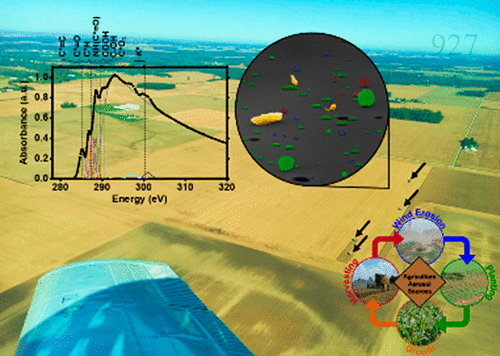当前位置:
X-MOL 学术
›
ACS Earth Space Chem.
›
论文详情
Our official English website, www.x-mol.net, welcomes your feedback! (Note: you will need to create a separate account there.)
Chemical Imaging of Fine Mode Atmospheric Particles Collected from a Research Aircraft over Agricultural Fields
ACS Earth and Space Chemistry ( IF 3.4 ) Pub Date : 2020-11-02 , DOI: 10.1021/acsearthspacechem.0c00172 Jay M. Tomlin 1 , Kevin A. Jankowski 1 , Felipe A. Rivera-Adorno 1 , Matthew Fraund 2 , Swarup China 3 , Brian H. Stirm 4 , Robert Kaeser 4 , Gregory S. Eakins 1 , Ryan C. Moffet 5 , Paul B. Shepson 1, 6 , Alexander Laskin 1
ACS Earth and Space Chemistry ( IF 3.4 ) Pub Date : 2020-11-02 , DOI: 10.1021/acsearthspacechem.0c00172 Jay M. Tomlin 1 , Kevin A. Jankowski 1 , Felipe A. Rivera-Adorno 1 , Matthew Fraund 2 , Swarup China 3 , Brian H. Stirm 4 , Robert Kaeser 4 , Gregory S. Eakins 1 , Ryan C. Moffet 5 , Paul B. Shepson 1, 6 , Alexander Laskin 1
Affiliation

|
Vegetation and crops in agricultural areas are a significant source of both biogenic secondary organic aerosols and of directly emitted primary biological atmospheric particles (PBAPs) composed of plant fragments/debris, fungal spores, pollen, and bacteria among others. Seasonal crop harvesting significantly intensifies regional PBAP emissions and aerosolizes soil organic matter and dust particulates. The atmospheric contributions and impact of PBAPs have been insufficiently investigated due to limited real-time observations and ambiguity in their detection by existing measurement techniques. We collected ambient particles on-board an instrumented Beechcraft BE76 Duchess research aircraft flying above actively harvested agriculture fields of corn and soybean crops. Particle samples were analyzed using complementary chemical imaging techniques, including computer-controlled scanning electron microscopy coupled with elemental microanalysis to describe particle-type population and scanning transmission X-ray microscopy to provide quantitative metrics on particle internal heterogeneity. We show the particle-class contribution is consistent between corn and soybean harvesting across altitudes of 100–300 m AGL. The contribution of PBAPs in the size range of 0.15–1.25 μm is estimated to be 10–12% of ∼39 000 analyzed particles. Determining viscosity with X-ray microanalysis has shown that the fine-mode organic particles collected are viscous/semisolid (102–1012 Pa s) while the majority of PBAP fragments are solid (>1012 Pa s). The observation of submicrometer, solid carbonaceous fragments of biogenic origin has implications for the regional cloud condensation nuclei and ice nuclei budget. Therefore, seasonal harvesting of crops may play an important, yet unrecognized, role in regional cloud formation and climate.
中文翻译:

从研究飞机在农业领域收集的精细模式大气颗粒的化学成像
农业地区的植被和农作物是生物成因的二级有机气溶胶和直接排放的主要生物大气颗粒(PBAP)的重要来源,这些颗粒由植物碎片/碎片,真菌孢子,花粉和细菌等组成。季节性作物收成大大加剧了区域性PBAP排放并雾化了土壤有机物和粉尘颗粒。由于有限的实时观测和现有测量技术对PBAP的大气影响和影响还没有得到足够的研究。我们在装有仪表的Beechcraft BE76公爵夫人研究飞机上收集了周围的颗粒,这些飞机飞越玉米和大豆作物的活跃收获的农业领域。使用互补化学成像技术分析了颗粒样品,包括计算机控制的扫描电子显微镜和元素微观分析,以描述颗粒类型的种群;扫描透射X射线显微镜,提供有关颗粒内部异质性的定量指标。我们显示,在100-300 m AGL的海拔范围内,玉米和大豆收获之间的颗粒级贡献是一致的。PBAP在0.15-1.25μm尺寸范围内的贡献估计约为39 000个被分析颗粒的10-12%。用X射线微分析法测定粘度表明,收集到的精细模式有机颗粒为粘性/半固体(10 我们显示,在100-300 m AGL的海拔范围内,玉米和大豆收获之间的颗粒级贡献是一致的。PBAP在0.15-1.25μm尺寸范围内的贡献估计约为39 000个被分析颗粒的10-12%。用X射线微分析法测定粘度表明,收集到的精细模式有机颗粒为粘性/半固体(10 我们显示,在100-300 m AGL的海拔范围内,玉米和大豆收获之间的颗粒级贡献是一致的。PBAP在0.15-1.25μm尺寸范围内的贡献估计约为39 000个被分析颗粒的10-12%。用X射线微分析法测定粘度表明,收集到的精细模式有机颗粒为粘性/半固体(102 –10 12 Pa s),而大多数PBAP碎片是固体(> 10 12 Pa s)。亚微米级,生物成因的固体碳质碎片的观察对区域云凝结核和冰核收支有影响。因此,农作物的季节性收获可能在区域云的形成和气候中起着重要但尚未被认识的作用。
更新日期:2020-11-19
中文翻译:

从研究飞机在农业领域收集的精细模式大气颗粒的化学成像
农业地区的植被和农作物是生物成因的二级有机气溶胶和直接排放的主要生物大气颗粒(PBAP)的重要来源,这些颗粒由植物碎片/碎片,真菌孢子,花粉和细菌等组成。季节性作物收成大大加剧了区域性PBAP排放并雾化了土壤有机物和粉尘颗粒。由于有限的实时观测和现有测量技术对PBAP的大气影响和影响还没有得到足够的研究。我们在装有仪表的Beechcraft BE76公爵夫人研究飞机上收集了周围的颗粒,这些飞机飞越玉米和大豆作物的活跃收获的农业领域。使用互补化学成像技术分析了颗粒样品,包括计算机控制的扫描电子显微镜和元素微观分析,以描述颗粒类型的种群;扫描透射X射线显微镜,提供有关颗粒内部异质性的定量指标。我们显示,在100-300 m AGL的海拔范围内,玉米和大豆收获之间的颗粒级贡献是一致的。PBAP在0.15-1.25μm尺寸范围内的贡献估计约为39 000个被分析颗粒的10-12%。用X射线微分析法测定粘度表明,收集到的精细模式有机颗粒为粘性/半固体(10 我们显示,在100-300 m AGL的海拔范围内,玉米和大豆收获之间的颗粒级贡献是一致的。PBAP在0.15-1.25μm尺寸范围内的贡献估计约为39 000个被分析颗粒的10-12%。用X射线微分析法测定粘度表明,收集到的精细模式有机颗粒为粘性/半固体(10 我们显示,在100-300 m AGL的海拔范围内,玉米和大豆收获之间的颗粒级贡献是一致的。PBAP在0.15-1.25μm尺寸范围内的贡献估计约为39 000个被分析颗粒的10-12%。用X射线微分析法测定粘度表明,收集到的精细模式有机颗粒为粘性/半固体(102 –10 12 Pa s),而大多数PBAP碎片是固体(> 10 12 Pa s)。亚微米级,生物成因的固体碳质碎片的观察对区域云凝结核和冰核收支有影响。因此,农作物的季节性收获可能在区域云的形成和气候中起着重要但尚未被认识的作用。


























 京公网安备 11010802027423号
京公网安备 11010802027423号